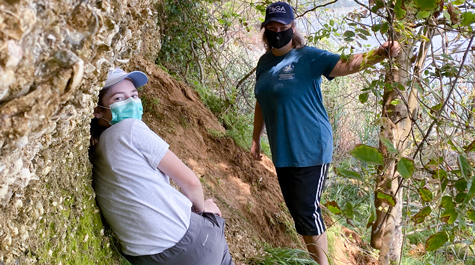Prehistoric research at a historic national park during the present pandemic
When people think of the Colonial National Historical Park, they think of, well…history.
It makes sense, as this unit of the National Park Service includes many historic sites, stretching across the Virginia Peninsula from Jamestown to the Yorktown Battlefield. But Vincent Santucci points out that the Colonial National Historical Park —also known as COLO — has a feature that goes back even farther than the landing at Jamestown: fossils.
Santucci is a senior paleontologist with the National Park Service. He explained that the NPS included COLO in a list of 279 fossil-bearing national parks.
“Although COLO is known for significant historic resources tied to why the lands were originally established as an NPS unit, fossils are important resources at COLO that we are trying to more fully understand through the paleontology inventory,” Santucci said.
A group from William & Mary’s Department of Geology, led by department Chair Rowan Lockwood, volunteered to help with the inventory. It was a valuable experience for the students, and especially so for Mackenzie Chriscoe ’21: She parlayed the internship into the topic for her senior thesis and a post-graduation job.
She also was tapped to write the cover story for an issue of Park Paleontology News, an NPS newsletter devoted to fossil interpretation, discovery and resource protection in U.S. national parks.
“The opportunity to gain support from some of the local expertise at William & Mary has resulted in a wonderfully successful partnership. The work of Mackenzie and the team revealed some really interesting and important fossil info that we wanted to showcase this work and partnership with W&M in our newsletter Park Paleontology,” Santucci said. “This has been a win-win for both the NPS and a young paleontologist during the early part of her career!”
Chriscoe said in an interview that her project was basically creating a paleontological inventory for COLO, recording all the fossil resources in the park and organizing the findings in stratigraphic columns. There are a lot of fossils in COLO, she said, for a very simple reason.
“Sea level used to be a lot higher here. There have been a lot of changes in sea level. While those changes are happening, there are all these organisms living and dying in the area,” she said. “And we were just lucky enough to have them preserved here in a few cliff areas in the park, which is really cool.”
Chriscoe detailed her work in her Park Paleontology article “Counting Fossils in Colonial Virginia.” She began her work in January 2020, she writes, with a literature review, the standard start for researchers. She created a list of taxa — class-order-family-genus-species — of fossils that had been found. Then, she and her team picked up their five-gallon buckets and mined the cliffs and outcrops for samples — after securing NPS permits to collect the fossils.
“By June, I started to feel like a true geologist, mud-stained shirts and all,” she wrote. “I led several field excursions that invariably produced soaked boots, sweat stains and enough sand trapped in my clothes to create a pocket beach when I returned home.”
Chriscoe’s article points out that the William & Mary geologists were continuing a tradition that predates the national park. The area was occupied by Europeans quite early and the eroding cliffs and outcrops of what became COLO made fossil collecting easy for natural philosophers as far back as the 17th century.
“The oldest fossils in the park date back to the Miocene, approximately nine million years ago,” she writes. “Interestingly, the geology in this area is complex, with no single cliff or outcrop that preserves the entire sequence for us to study.”
And Chriscoe points out that the research was done during a pandemic, which added another logistic layer or two to the work. Out on the collecting site, all of the team wore masks and maintained the requisite six feet of physical separation. She admits the masks became tedious, doing hard work under a summer sun in temperatures that usually rose near 100 and humidity that hit 100 more days than not. They coped by supplementing university COVID guidelines with some of their own: ice water, ice cream and the prospect of ending the day with an al fresco clam strip dinner at the Yorktown Pub.
The physical distancing became awkward only when it came time to move hunks of fossil matrix that were too heavy for one person. The specimens would be processed at the Paleontology Lab at William & Mary in normal times, but Chriscoe took work home, cobbling together a lab space on her family’s screened-in porch.
“Unfortunately, I will have to uncobble this lab and clean up all the leftover sediment, because I’ve been told that it detracts from the view and keeps getting tracked into the house,” she writes.
All their work paid off. Santucci and others at the NPS were sufficiently impressed with Chriscoe’s contribution to offer her a job when she graduates.
“So this will be actually a two year project for me,” she said. “They will be taking me on as a scientist intern. I'll continue doing similar work with more of a focus on education and outreach within COLO and focusing on the fossils.”
 Skip to main content
Skip to main content

